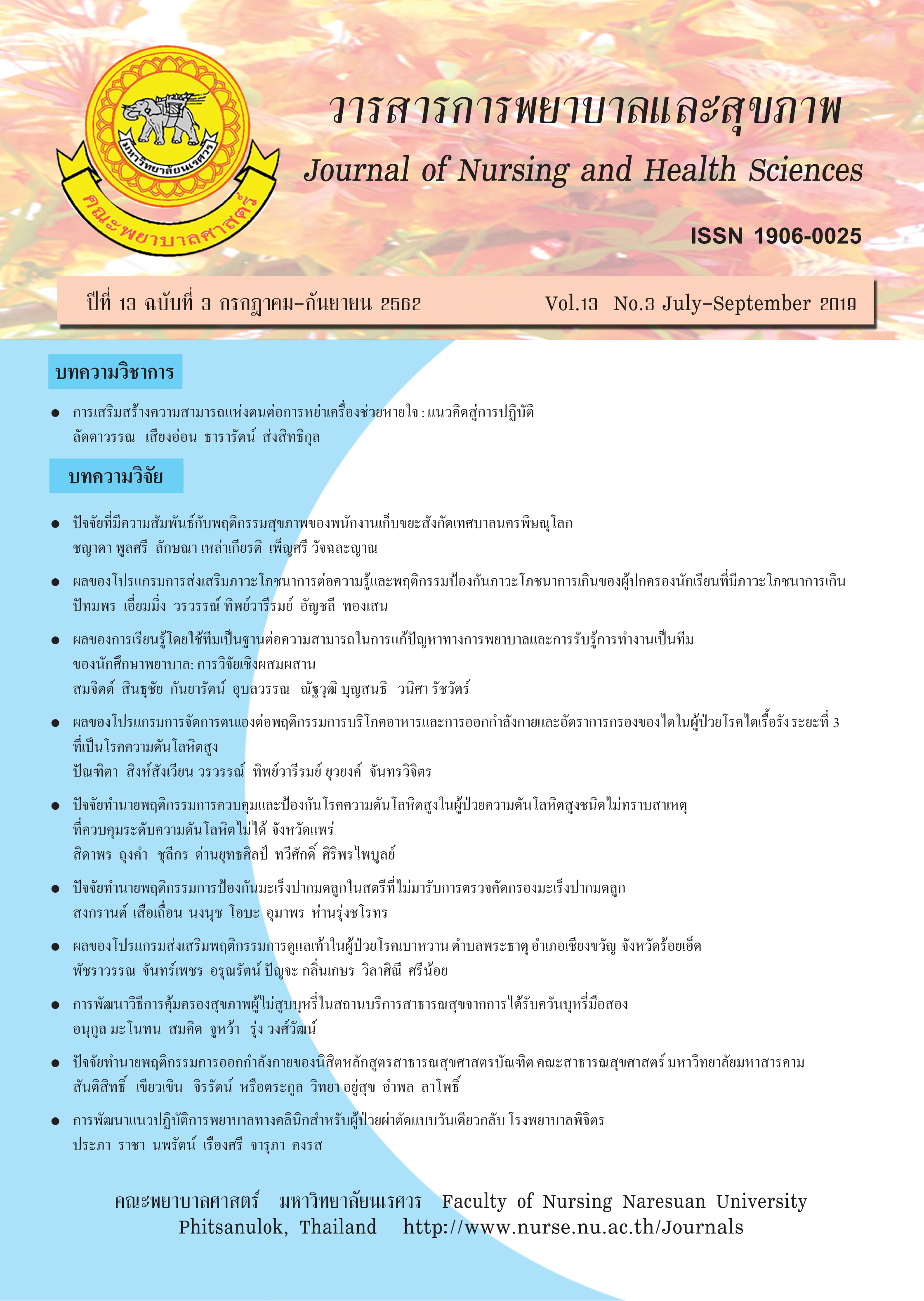ปัจจัยทำนายพฤติกรรมการป้องกันมะเร็งปากมดลูกในสตรีที่ไม่มารับการตรวจคัดกรองมะเร็งปากมดลูก
Main Article Content
บทคัดย่อ
การวิจัยเชิงพรรณนานี้ มีวัตถุประสงค์เพื่อศึกษา ปัจจัยทำนายพฤติกรรมการป้องกันมะเร็งปากมดลูกของสตรีที่ไม่มารับการตรวจคัดกรองมะเร็งปากมดลูก อำเภอไพศาลี จังหวัดนครสวรรค์ กลุ่มตัวอย่างคือสตรีวัยเจริญพันธุ์ที่ไม่มารับการตรวจคัดรองมะเร็งปากมดลูกในปี พ.ศ.2558-2560 จำนวน 377 คนคัดเลือก ด้วยวิธีสุ่มอย่างง่าย จากโรงพยาบาลส่งเสริมสุขภาพตำบล 5 แห่ง ในอำเภอไพศาลี จังหวัดนครสวรรค์ เก็บรวบรวมข้อมูลด้วยแบบสอบถามประกอบด้วย ข้อมูลทั่วไป แบบวัดความรู้เกี่ยวกับโรคมะเร็งปากมดลูก แบบสอบถามปัจจัยด้านการรับรู้ ได้แก่ การรับรู้โอกาสเสี่ยงที่จะเกิดมะเร็งปากมดลูก การรับรู้ความรุนแรงของโรคมะเร็งปากมดลูก การรับรู้ประโยชน์ของการปฏิบัติพฤติกรรม การรับรู้อุปสรรคของการปฏิบัติพฤติกรรม และสิ่งชี้นำการกระทำ ได้แก่ การรณรงค์จากสื่อและสิ่งพิมพ์ การแนะนำจากเพื่อนหรือบุคลากรสาธารณสุข ความเจ็บป่วยของคนในครอบครัวหรือชุมชน และแบบสอบถามพฤติกรรมการป้องกันมะเร็งปากมดลูก สถิติที่ใช้วิเคราะห์ได้แก่ การแจกแจงความถี่ ร้อยละ ค่าเฉลี่ย และส่วนเบี่ยงเบนมาตรฐาน ไคสแควร์ สหสัมพันธ์เพียรสัน และการวิเคราะห์ถดถอยพหุคูณแบบเอ็นเทอร์ (Enter multiple regressions Analysis)
ผลการวิจัยพบว่า สตรีที่ไม่มาตรวจคัดกรองมะเร็งปากมดลูกมีพฤติกรรมป้องกันมะเร็งปากมดลูกอยู่ในระดับดี ( =2.80, S.D.= 0.587) ตัวแปรที่ทำนายพฤติกรรมป้องกันมะเร็งปากมดลูกในสตรีที่ไม่มาตรวจคัดกรองมะเร็งปากมดลูกคือ การรับรู้ประโยชน์ของการปฏิบัติพฤติกรรม การรับรู้อุปสรรคของการปฏิบัติพฤติกรรม และความเจ็บป่วยของคนในครอบครัวหรือชุมชน โดยสามารถร่วมทำนายได้ร้อยละ 24.7 อย่างมีนัยสำคัญทางสถิติที่ ระดับ .001
Article Details
เอกสารอ้างอิง
Becker, M.H., Rosenstock, I.M., Kirscht, J.P., Haefner, D.P., & Kasl, S.V. (1974). The health belief model and personal health behavior. New Jersey: Charles B. Slack.
Bloom, B.s., Hasting, J.T., & Madaus. G.F. (1971). Handbook on formative and summative evaiuation of student learning. New York: Megrew-Hill.
Department of Health, Ministry of Public Health. (2015). Comprehensive cervical cancer control: Important practices bureau of reproductive health. Retrieved 20 April 2017 from http://www. http:// rh.anamai. moph.go.th /download/all_ file/brochure/Cervical cancer.pdf. [In Thai].
Homchun, T., Vatanasomboon, P., Temsirikulchai, L., & Lapvongwatana, P. (2013). Primary cervical cancer preventive behaviors among beer bar waitresses at Pattaya City, Chonburi Province. Journal of Health Education, 36(124), 1-16. [In Thai].
Juntawong, N., Tridech, P., Siri, S., & Tridech, C. (2017). Factors related to receiving cervical cancer screening services among women aged 30-60 years in Muang District, Pathumthani Province. Journal of Phrapokklao Nursing College, 28(1), 63-79. [In Thai].
Kanjanapisan, N. (2010). Factors relating to preventive health behavior regarding cervical cancer among women in Tombon Donmanora, Bang Khanthi District, Samut Songkhram. Master thesis (Science), Kasetsart University, Bangkok. [In Thai].
Nakhonsawan Provincial Health Office. (2017). Form of performance report, indicators according to service system development plan health (Service plan) cancer branch Nakhon Sawan Province, fiscal year 2016. Nakhon Sawan: Nakhonsawan Provincial Health Office. [In Thai].
Duangkaew, N. (2008). Health belief and preventive behaviors of risk group diabetes mellitus in Ko Kha District Lampang Province. Master Thesis (Public Health), Chiang Mai University, Chiang Mai. [In Thai].
National Cancer Institute, Department of Medical Services. (2010). Cervical cancer screening policy. N.P. [In Thai].
Rueangsukjaroen, S. (2012). Nursing of cancer patients. Samutprakan: Sintawekit printing. [In Thai].
Rungrueang, P., Vatanasomboon, P., Tansakoon, S., & Termsirikulchai, L. (2015). Factors related to cervical cancer screening behavior among at risk group of women never been screened within the past 3 years. Veridian E-Journal, Science and Technology Silpakorn University, 2(2), 36-49. [In Thai].
Sripiboonbat, J., Moopayak, K. Priyatruk, P., & Ruangiratain, S. (2011). Factors related to the use of cervical cancer screening services by women living in catchments area of Primary Care Units. Journal of Nursing Science, 29(2), 82-92. [In Thai].
Srisatidnarakul, B. (2004). The methodology in nursing research (3th ed). Bangkok: U and I intermedia, Ltd. [In Thai].
Srisomboon, J. (2006). Human papilloma virus and cervical cancer. Bangkok: Tims. (Thailand), Limited. [In Thai].
Summutte, U., & Pinitsoontorn, S. (2015). The intention to cervical cancer screening utilization among 30-60 year old women at Banprow Health Promotion Hospital, Mueang District, Nong Bua Lam Phu Province. Community health development quarterly Khon Kaen University 3(4), 529-546. [In Thai].
Techsavapak, K., & Konglampan, C. (2017). Impact factors of cervical cancer screening in muslim womenat Nongjok District, Bangkok. Kuakarun Journal of Nursing 23(2), 232-246. [In Thai].
Termtanakitphaisan, A. (2015). End of cervical cancer. Srinagarind Medical Journal, 30(suppl), 7-9. [In Thai].
Thananowan, N., & Tulyatorn, P. (2010). Gynecological nursing textbook (holistic edition). Bankok: V. Print (1991), Ltd.[In Thai].
Tunkul, A., & Rueangkajorn, I. (2016). Cancer screening in women. Ramathibodi Medicine Journal, 39(4), 256-258. [In Thai].


